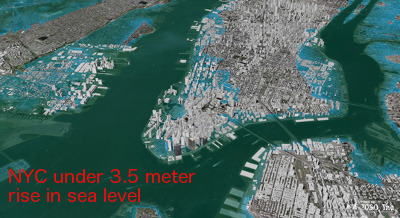CLIMATE AND SCIENCE FICTION
/
Photo from Architecture 2030
Climatologist James Hansen of Columbia University has sounded the alarm: the rate of melting of Antarctic ice as recently measured means that, if rising levels of atmospheric carbon dioxide aren’t soon reversed, large coastal areas of the planet could be flooded within as little as fifty years due to increases in sea level as much as nine meters.
It’s not science fiction. If you live in a coastal city, you should be concerned, along with millions upon millions of the world’s citizens.
This is far faster and much more drastic than earlier predictions of sea level rise, and it’s based on a global average temperature increase of just 2 Celsius degrees. That figure could go much higher if something isn’t done soon to reduce CO2 in the atmosphere. Yet when it comes to supporting solutions to the problem, governments lumber like dinosaurs in a tar pit (one of the sources of planet-heating fossil fuels perhaps?)
There are a number of web resources that show reputable assessments of how coastal population centres will suffer as sea levels rise. The NOAA has a good one here, and there’s a more complicated one here. National Geographic has a page to show what the world would be like if all of the ice melted, but that’s not likely to happen anytime soon (and even that won’t make you think you’re in a certain Kevin Costner movie). All of these will give you a chill, or possibly a thrill in a disaster-movie kind of way. Looking at them reminded me of all of the science fiction that has dealt with climate over the years.
One of the first to make an impact on me was J.G. Ballard’s The Wind From Nowhere, a 1961 novel that painted the terrible effects on human civilization of a non-stop hurricane force wind. It was probably one of the first books to get me hooked on apocalyptic scenarios. But it was far from alone. The Encyclopedia of Science Fiction offers a pretty good overview of the SF written on the subject of climate disasters, and you can find other pop culture references here. Maybe we’re fascinated with the topic of weather disasters just because we’re obsessed with the weather. We talk about it every time we have nothing else urgent to say, and much of the rest of the time too. It’s so prevalent in fiction that “man vs. nature” is one of the four main types of conflict taught in every literature class. (In case you’ve forgotten, the others are man vs. man, man vs. society, and man vs. himself.)
Perhaps there’s a special poignancy in vicariously witnessing a human being’s struggle against something awesomely powerful for which he or she is not to blame. Ah, except this time there’s plenty of evidence that, collectively, we are to blame. The climate change James Hansen warns about isn’t caused by solar flares, or a black alien cloud that blocks the sun, or an asteroid strike. We’re doing it to ourselves, and to others. Each of us could do something to stop it, but we have to make that choice. Which means that the current climate scenario incorporates all four of the classic forms of conflict mentioned above.
That makes for a heck of a story, but it’s one I’d rather read than live, thanks very much.

